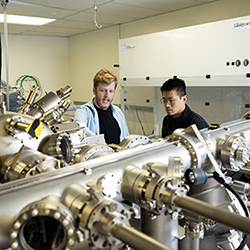

Research Terms
Researchers at the University of Central Florida have developed a lensless fiber-optic imaging system that overcomes the expense and complications associated with existing multicore and multimode fiber-based imaging systems (MCFs, MMFs). More robust, compact and durable, the UCF technology can produce artifact-free images and reach an imaging depth of up to several millimeters without any distal optics. The new system also tolerates bending and temperature changes better than MCFs and MMFs.
The innovation could help to reduce the size of image-transmitting endoscopes down to the diameter of the fiber itself and minimize penetration damage without degrading image quality. As a result, the fiber could collect artifact-free images of organs without touching them directly; thus, enabling a minimally invasive, high-performance imaging system.
Technical Details
The UCF fiber optical imaging system comprises two main parts: a disordered glass-air Anderson localized optical fiber (GALOF) that provides low-loss image transmission and a trained deep convolutional neural network (DCNN) of algorithms that enable the accurate reconstruction of raw images. The unique DCNN-GALOF combination offers advantages in resolution, depth perception, and environmental stability over conventional fiber-optic imaging methods. It also allows for physical movement of the specialty fiber without interruption of the real-time imaging process. Experimental results indicate that image quality and system performance are unaffected by a bending angle of approximately 3 degrees or by heating of up to 50 degrees Celsius.
In one example application of the system, the imaging fiber is a meter-long GALOF made of air and silica glass (to create the random refractive index structure--though other oxide glass mixtures are usable). It uses no distal optics. The system employs incoherent light (a low-cost LED) to illuminate various structures of human red blood cells. Within the system, a DCNN model is tailored (trained) to reconstruct and classify images. Instead of relying on known models and priors, the DCNN undergoes a training process using a large dataset collected from samples of the cell structures. In this way, it directly learns the underlying physics of the imaging transmission system without any advanced knowledge. In effect, it optimizes the network and enables it to reconstruct and classify the input images even if a particular type of image is not in the training data set. The trained DCNN is a precise approximation of the mapping function between the measured imaging data and the input imaging data and therefore enables a prediction process that takes less than one second.
Partnering Opportunity
The research team is looking for partners to develop the technology further for commercialization.
Stage of Development
Demonstration system available.
The University of Central Florida invention enables a photonic iterative solver (PIS) for many large-scale linear inverse and optimization science and engineering problems. Example applications include matrix inversion, image reconstruction, high-dimensional inverse problems, numerical eigen problems, and ab initio ray-tracing engines.
Conventional iterative solvers with floating-point computing units are slow and inefficient at handling large-scale or high-dimensional data. Though systems using a fixed-point data format have the potential to train large-scale neural networks, fixed-point is not suitable for iterative solvers that require precision on the output. The limited precision can stagnate the iterative solver before reaching the optimal solution. Also, existing fixed-point iterative solvers in analog computing hardware have no error management mechanisms to resolve the error stagnation problem.
The UCF solution offers a hybrid analog and digital computational system that uses a dynamic fixed-point format to reach the same precision level as a conventional floating-point iterative solver. Compatible with the latest hardware advancements in high-performance computing, the invention achieves high speed and energy efficiency with fixed-point, highly parallelized architecture.
Technical Details: The UCF invention comprises a system, computer program product, and method of creating a hybrid analog and digital computational system. It incorporates a residual iterative algorithm to solve the set of solution values for equations. The residual iterative algorithm includes an outer update loop computed using a digital computing device with residue values initially set to a first initial value and a set of solution update values set to a second initial value.
The residual iterative algorithm also includes an inner residual loop that is iteratively computed using an analog accelerator until one or more inner residual loop stopping criteria are met and return a set of solution update values. Next, the system uses the new values to update the set of residue values and a range of the next set of solution update values, thereby adjusting the computational precision of the inner residual loop.
Partnering Opportunity: The research team is looking for partners to develop the technology further for commercialization.
Stage of Development: Prototype available.
The University of Central Florida invention is an image-based system for gauging the volume of fluids in a container, regardless of morphology. By imaging the optical absorption of a liquid, the method enables accurate volume measurement, even while the fluid is splashing around within a container.
Though many specialized volume gauging systems for enclosed containers exist, few can adapt to extreme fluid morphologies as the UCF invention can. For example, in reduced gravity environments, fluids tend to coalesce and float in large droplets which have no contact with the walls of the container, violating the operating principles of existing technologies.
Technical Details
The image-based UCF invention enables continuous, dynamic tracking of fluid inside an enclosed container. A key aspect is that the system can perform volume gauging regardless of the liquid’s morphology. In one example application, the system setup can include:
The volume of the fluid may be determined based on one or more images through various techniques including, but not limited to, direct calculations associated with measured absorbance of the light by the fluid or indirect calculations using a machine learning algorithm.
Partnering Opportunity
The research team is seeking partners for licensing and/or research collaboration.
Stage of Development
Prototype available.
The University of Central Florida invention is an adaptive system that enables adjustable ranges for parameters and intermediary variables while greatly reducing computer power consumption. The invention determines the adjustable ranges based on the statistics of the parameters/variables during the adaptation process, which reduces errors caused by clipping or low precision and offers improved performance in range-limited adaptive systems.
Unlike other adaptive systems that rely on floating-point numbers for all or a portion of their parameters, the UCF invention uses fixed-point data types and does not use floating-point numbers. In one example application, the UCF adaptive system can effectively train artificial neural networks (ANNs). A class of adaptive systems, ANNs transform inputs (such as text, audio, images, and videos) to outputs of desired formats to achieve various tasks.
Technical Details: The UCF invention comprises an adaptive system (such as an adaptive control system, an adaptive proportional-integral-derivative (PID) controller, or an ANN) and a novel method for adjusting a parameter in the system. For instance, a parameter (fixed-point or analog) with a finite range is adjusted based on a difference between the output signal and a target output signal. Typically, the parameter is an analog electrical signal, a digital electrical signal, an analog optical signal, a digital optical signal, or a digital-and-analog hybrid signal.
Finite ranges of individual parameters are adjusted based on the statistics of the parameter values. For an individual parameter, the statistical distribution can be estimated from the historical values of the parameters during the adaptation process. As an example, if the adaptive system employs discrete, iterative feedback steps, such as those in a reinforcement learning system, the distribution can be fitted from the parameter values from the previous iterations. In another example, if the adaptive system employs continuous feedback, such as a real-time motion system, the distribution can be fitted from a portion of or the whole time series of the parameter in the past.
Partnering Opportunity: The research team is seeking partners for licensing, research collaboration, or both.
Stage of Development: Prototype available.
The University of Central Florida invention is a photonic matrix accelerator that works with floating-point numbers. Other photonic accelerators only work with fixed-point numbers, significantly limiting the dynamic range of analog neural networks (ANNs). With the UCF floating-point photonic accelerator (FPA), multiplications are performed by coherent mixing and accumulations are performed in the spatial-mode or wavelength domain. The UCF power-efficient floating-point analog tensor accelerator provides a foundational and vertical technology applicable across the spectrum of applications in harnessing artificial intelligence for both commercial and defense applications.
Technical Details
The UCF approach effectively enhances the dynamic range of analog computation. However, repeated updates of the ANN weight matrix are required in training processes, and this configuration always needs high-speed modulation, since accumulations are implemented using time-division multiplexing (TDM), resulting in excessive energy expenditure. This construction has a direct implication to the invention’s scalability. For example, assume that the integration time for accumulation is 200 picoseconds, corresponding to a 5 gigahertz (GHz) clock rate. Using a maximum modulation speed of 500 GHz, the number of weights per column is only 100. Thus, the approach can be scaled to much larger sizes and encode a greater number of exponent levels.

















